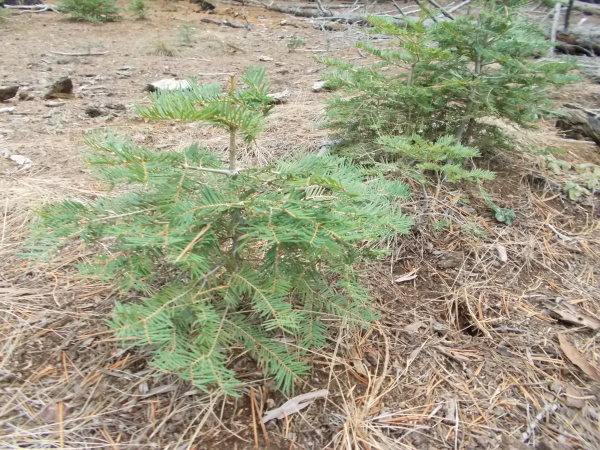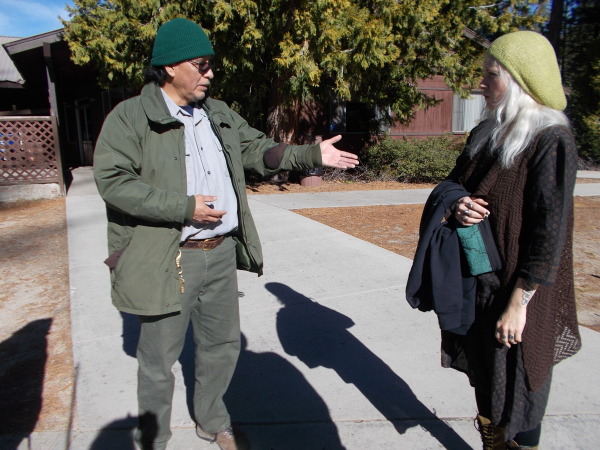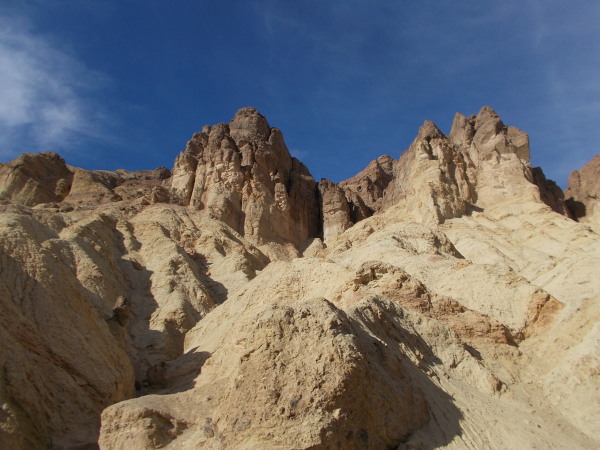California is home to the giant sequoias. John Muir commented that
“No other tree has looked down on so many centuries as the Sequoia”.
Some of them are over 2000 years old.
We are now entering King’s Canyon and the Sequoia National Parks. We visit the Grant tree, which is the biggest living tree by width, and later the Sherman tree, which is the biggest by volume. It is breathtaking to be in the presence of these natural giants. I find lying down is the only way to gain the perspective to fit one all in the frame when photographing them. Often once I am laying on the earth looking up I just stay where I am for a while, either gazing up at the canopy or closing my eyes and feeling myself sinking into the earth or putting down roots which go deep, mingling with the sequoia roots. These trees have a very high tannin content which helps protect them from fire. Some trees have survived around 80 fires in their lifetime. Hiking along the Congress trail – the name given to a walking route through the Sequoia forest – one can see these sequoias standing in groups. I notice also the tiny sequoia saplings sprouting from the forest floor. It is amazing to think that one day some of these may grow to be as old and majestic as their forefathers.
Later in the evening, after we have hiked to meet the trees, I return to the book I am reading ‘Bury My Heart at Wounded Knee’ by Dee Brown, a Native history of the American West. I read about General Sherman, an old war dog whose actions contributed greatly to the Native’s loss of land and genocide. This leaves a bitter taste in my mouth, to discover that these majestic trees which have been in existence for many centuries have been named after such individuals.
We watch the sun go down from atop a rock high up in the forest. The warm light illuminates the trees making the bark looks as if it is on fire. They truly live up to their name of Redwoods. We head back to our cabin, where the log burner was left burning low and the room is cosy and inviting. After dinner we wrap up warm and drive up a twisting road, then walk a path up to Panoramic Point. I am mindful that this is bear country and despite a slight fear of actually encountering one for real, there is a part of me which would actually like to see one. I know that if I do, I am supposed to make loud noises and wave my arms to make me seem bigger. I asked the receptionist at the lodge about this and she has done this on many occasions. I can’t help but think of Yogi Bear and his penchant for picnics. It feels like the top of the world at Panoramic Point. We can see for miles. There are snow capped mountains in the distance and we can see everything so well by the light of the full moon. Emma and I see a shooting star within minutes of arriving. There is a large boulder resting under a pine tree and someone has thoughtfully left a fallen tree trunk leaning up to it. I walk up the tree trunk and climb up onto the boulder using it’s rough surface as hand holds and the pine tree behind me for leverage. Now I really do feel at the top of the world. Climbing down, I join Emma and Sohel on the blanket and lie down to stargaze a little longer. I see yet another shooting star. When we are too cold we return to the cabin feeling blessed to have witnessed such a wonderful natural light show. On the way back, almost at the cabin, we stop to watch a young deer who crosses the road in front of us. She also stops and turns to watch us. We stay like this for over a minute. I can tell she is young as she is small and looks like she hasn’t yet grown into her ears they are so large. Eventually she wanders off. What a beautiful encounter to end our day.
The following day we hike though more forest, ending the day by climbing the several hundred steps up to Moro Rock, a huge granite boulder. This is an ideal place to watch the sun set. As the sky turns red in the west, the white snow covered mountain range behind us in the east turn a soft pink. The urban lights below start to twinkle and shimmer as the sun disappears. It is good to look down on the world from such a high viewpoint from time to time. It helps put everything into perspective somewhat, the same as gazing up at the stars. All those things we worry or stress about seem to shrink into insignificance. It is like a reality check, being reminded that we are but a very small part of something greater.
We meet two rangers as we are leaving the park the next day. They ask where we are from and are happy to chat awhile. Ray is Native American and an artist. He tells us he lives at Flagstaff, a reservation in Arizona. He gives each of us his card and tells us we would be welcome to visit Flagstaff. I tell him I am reading “Wounded Knee” and learning the Native’s history of the American West while I am here. He agrees it is important to know the truth of the genocide that happened. We discuss the disconnectedness of many people from nature and that it is this interconnectedness which is integral to the Native’s way of life, as in all Ancient and Shamanic cultures. We agree that there is a shift occurring as many people are returning to simpler ways of life more in harmony with and respectful of nature. The other ranger, Bret, runs a publishing company with his wife, and passes me his bookmark business card. I tell him I am blogging about my trip and he says they have published a blog as a book. He asks for the blog address and encourages me to stay in touch, just in case. They do say everyone has a book in them…
We stop at Hume lake, a man-made lake created in the late 1800s for the logging industry. The area was home to this booming business, home to 1000 loggers until the first world war, recession and a couple of fires ended it. Nature reclaimed the area, trees were replanted and now the lake is an area of natural beauty, surrounded by lush pine forest. It is unusually warm for a lake due to it’s shallowness and as we arrive the sun is shining and glinting off the surface and I am tempted to swim. I settle with paddling my feet in the water. Emma and Sohel head off to hike and I find a boulder a few feet from the water’s edge, lay my coat down on the sand and lie down. It is so serene here, I feel totally at peace. The sun is warms my skin and the breeze cools me from the left. The sound of ducks splashing and quacking, distant cries of a raven and the knocking of a woodpecker echoes from the trees. Dappled light plays across the course bark of the pine tree to my right; backlit pines stand tall and majestic beyond the lake; the light glints off the water’s surface in hundreds of tiny crystals in front of me; the wind gently rippling the water making the points of light dance; Wispy clouds in the blue sky above me look like candyfloss. Total tranquility. I feel connected, like nature is recharging me. So much gratitude for being here, for the opportunity to make this journey and experience these wild wonders of nature. It really is the best medicine. I was lucky enough to grow up in a quite rural area, spending time outside, exploring and climbing trees. So many people today, especially young people, do not have such opportunity to connect with nature. The Industrial Revolution brought people to cities, to work in factories etc. Now technology has taken the fore and so many people grow up in urban environments, spending time indoors and in front of screens, disconnected from nature, from what we are naturally a part of. It causes sickness. We need to balance. Not so long ago we lived so much closer to nature, in tune with it’s cycles and seasons. We slept when it was dark and awoke with the sun. We used to take what we needed and give thanks, respecting the plant and animals that nourished us. Now many are so far away from that. I hope that one day in the not-too distant future I have the means to grow some of my own food, to keep chickens for eggs and maybe even a goat for milk. Whether alone, in partnership or in community I believe I can make this dream a reality.
Looking at a map we there is no direct route from the Sequoia National Park to Death Valley. We have to head south through Bakersfield, then back up, in a big loop. It is an estimated six hour drive. We set off at six pm, expecting to arrive around midnight. Initially we travel along the winding roads of the mountains, looking up to an increasing amount of stars in the sky. We pull over briefly and Emma and I lie on the floor in a lay-by and star gaze for a short time. It is so clear we can see the Milky Way. As I mention that I plan to attempt making some photographs of the moon through a friend’s telescope I see a shooting star in the periphery of my vision. I take it as a good sign and resolve to make this plan a reality.
We stop at a gas station we see along the way in a small ghetto-type town called Cutler. There is no gas here. We stop at the next one, which does have gas, and the attendant is an Indian guy living in Fresno. He comments in a friendly way that I look as if I am not from here. Everyone I see looks Mexican and the town certainly has a Mexican feel. We drive on, and as we reach the outskirts of town we see some sort of cattle farm where the cows are outside in fields but restricted inside a large network of metal pens. We are disgusted by this sight, then are hit by a stench of what can only be described as an overpowering meaty death smell. It is gross. We are amazed at how there are houses nearby. People actually live here inhaling this air. I can only imagine they have become immune to it. This puts the Macdonalds we saw a few miles earlier in an even worse light. It is such a contrast to the vast expanses of wild nature we were in a short time ago. We later learn that this is dairy farm country.
Fog descends a little further on. We can only see a few metres in front of us it is so thick. Thankfully we are now on a highway so it is more or less straight. The idea of more twisting turning mountain roads in the fog, like our journey to Lake Tahoe, really does not appeal.
I drift to sleep and as I awake in just after midnight we in the Mojave desert, arriving at a Western themed rustic lodge motel. It has a saloon bar, gift shop and even a pool, although at this hour all I want is a comfortable bed. The next day we drive into Death Valley, one of the hottest places on earth. Even in December it is near 20 degrees. It must be unbearable in the summer months. The hottest temperature ever recorded here was 57 degrees celsius in July 1913. We stop to walk across some sand dunes and I go barefoot, enjoying the feel of the sand between my toes. It is crazy to think that only a few days ago, in the very same state of California we experienced snow! We travel further along our route, driving up Badwater Road and stop to walk to Cathedral rocks. We clamber up high and are rewarded with stunning views for many miles.




